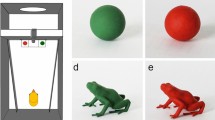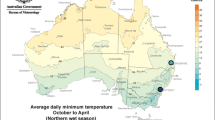Summary
Young chicks were offered a choice of warningly coloured black and yellow and non-warningly coloured green (or olive) prey. Unfed chicks were given palatable painted mealworms on their first day. They directed their first peck at both colour types at the same probability; however, they ate the warningly coloured ones at a much lower rate. This is due to an inhibition of attack which becomes effective after pecking. Chicks which were a few days old showed the same behaviour. Since the control prey was in this case painted with an olive mixture containing the same colours as the warningly coloured mealworms, it can be concluded that the inhibition is caused by the black and yellow coloration. With accumulating positive experience of the chicks, the inhibition decreased. For permanent avoidance it must therefore be supplemented by unpleasant experience. Accordingly, chicks handled the unpalatable black and yellow ringed caterpillars of Tyria jacobaeae only a few times and always for a short period when offered repeatedly. The inhibition caused by the black and yellow pattern is attributed to a genetically fixed predisposition to avoid warningly coloured black and yellow prey which is the result of evolutionary adaptation.
Similar content being viewed by others
References
Apin RT, Benn MH, Rothschild M (1968) Poisonous alkaloids in the body tissues of the cinnabar moth (Callimorpha jacobaeae L.). Nature 219:747–748
Bergmann A (1953) Die Großschmetterlinge Mitteldeutschlands, vol. 3, Spinner und Schwärmer. Urania, Jena
Brower JVZ (1958) Experimental studies of mimicry in some North American butterflies. I. The monarch, Dannus plexippus, and viceroy Limenitis a. archippus. Evolution 12:32–47
Brower LP (1969) Ecological chemistry. Sci Am 220(2):22–29
Caldwell GS, Rubinoff RW (1983) Avoidance of venomous sea snakes by naive herons and egrets. Auk 100:195–198
Collias NE, Collias EC (1967) A field study of the red jungle fowl in north-central India. Condor 69:360–386
Coppinger RP (1970) The effect of experience and novelty on avian feeding behavior with reference to the evolution of warning coloration in butterflies. II. Reactions of naive birds to novel insects. Am Nat 104:323–335
Curio E (1976) The ethology of predation. Springer, Berlin Heidelberg New York
Davies NB, Green RE (1976) The development and ecological significance of feeding techniques in the reed warbler (Acrocephalus scirpaccus). Anim Behav 24:213–229
Edmunds M (1974) Defense in animals. Longman, Harlow
Evans DL, Waldbauer GP (1982) Behavior of adult and naive birds when presented with a bumblebee and its mimic. Z Tierpsychol 59:247–259
Fischer GL, Morris GL, Ruhsam JP (1975) Color pecking preferences in white leghorn chicks. J Comp Physiol Psychol 88:402–406
Fölsch DW, Stahel P (1982) Auslaufhaltung für Hühner, 2. Aufl. Wirz. Aarau
Gehlbach FR (1972) Coral snake mimicry reconsidered: The strategy of self-mimicry. Forma Functio 5:311–320
Glutz von Blotzheim UN, Bauer KM, Bezzel E (1973) Galliformes und Gruiformes. In: Handbuch der Vögel Mitteleuropas, vol 5. Akademische Verlagsgesellschaft, Frankfurt am Main
Goodwin EB, Hess EH (1969) Innate visual form preferences in the pecking behavior of young chicks. Behaviour 34:223–237
Harvey PH, Greenwood PJ (1978) Anti-predator defence strategies: some evolutionary problems. In: Krebs JR, Davies NB (eds) Behavioural ecology: an evolutionary approach. Blackwell, Oxford, pp 129–154
Hess PH (1956) Natural peferences of chicks and ducklings for objects of different colors. Psychol Rep 2:477–483
Hess EH (1973) Imprinting. Van Nostrand Reinhold, New York. Cited from German Transaltion: (1975) Prägung. Kindler, München
Hogan JA (1965) An experimental study of conflict and fear: an analysis of behavior of young chicks toward a mealworm. Part I. The behavior of chicks which do not eat the mealworm. Behaviour 25:45–97
Hogan JA (1966) An experimental study of conflict and fear: an analysis of behavior of young chicks toward a mealworm. Part II. The behavior of chicks which eat the mealworm. Behaviour 27:273–289
Järvi T, Sillén-Tullberg B, Wiklund C (1981) The cost of being aposematic. An experimental study of predation on larvae of Papilio machaon by the great tit Parus major. Oikos 36:267–272
Koenig L (1950) Untersuchungen über Nahrungserwerb und Beuteschema des Bienenfressers. Zool Inf (Biol Stat Wilhelminenburg) 2
Kovach JK (1978) Sources of individual variation in the naive approach preferences of quail chicks: age, stimulus intensity, and genotypes. Behaviour 64:173–183
Kovach JK (1983) Perceptual imprinting: genetically variable response tendencies, selective learning, and the phenotypic expression of colour and pattern preferences in quail chicks (C coturnix japonica). Behaviour 86:72–88
McBride G, Parer IP, Foenander F (1969) The social organisation and behaviour of the feral domestic fowl. Anim Behav Monogr 2:127–181
McCornack RL (1965) Extended tables of the Wilcoxon matched pair signed rank statistic. J Am Stat Assoc 60:864–871
Morgan CL (1896) Habit and instinct. Arnold, London. Cited from German translation: (1909) Instinkt und Gewohnheit. Übersetzt von Maria Semon. Teubner, Leipzig Berlin
Mostler G (1935) Beobachtungen zur Frage der Wespenmimikry. Z Morphol Oekol Tiere 29:381–455
Rohlf FJ, Sokal RR (1969) Statistical tables. Freeman, San Francisco, Calif
Rubinoff I, Kropach C (1970) Differential reactions of atlantic and pacific predators to sea snakes. Nature 228:1288–1290
Schneider D (1954) Beitrag zu einer Analyse des Beute- und Fluchtverhaltens einheimischer Anuren. Biol Zentralbl 73:225–282
Schuler W (1982) Zur Funktion von Warnfarben: Die Reaktion jurger Stare auf wespenähnlich schwarz-gelbe Attrappen. Z Tierpsychol 58:66–78
Scott ML, Austic RE, Gries CL (1978) Nutritional deficiency diseases. In: Hofstad MS (ed) Deseases of poultry, 7th edn. Iowa State University Press, Ames, pp 49–78
Siegel S (1956) Nonparametic statistics for the behavioral sciences. McGraw Hill, New York
Smith SM (1975) Innate reconition of coral snake pattern by a possible avian predator. Science 187:759–760
Smith SM (1977) Coral-snake pattern recognition and stimulus generalisation by naive great kiskadees (Aves: Tyrannidae). Nature 265:535–536
Smith SM (1980) Responses of naive temperate birds to warning coloration. Am Midl Nat 103:346–352
Wallman J (1979) A minimal visual restriction experiment: Preventing chicks from seeing their feet affects later responses to mealworms. Dev Psychobiol 12:391–397
Wickler W (1968) Mimikry. Kindler, München
Wiklund C, Järvi T (1982) Survival of distasteful insects after being attacked by naive birds: A reappraisal of the theory of aposematic coloration evolving through individual selection. Evolution 36:998–1002
Windecker W (1939) Euchelia (Hypocrita) jacobaeae L. und das Schutztrachtenproblem. Z Morphol Oekol Tiere 35:84–138
Author information
Authors and Affiliations
Rights and permissions
About this article
Cite this article
Schuler, W., Hesse, E. On the function of warning coloration: a black and yellow pattern inhibits prey-attack by naive domestic chicks. Behav Ecol Sociobiol 16, 249–255 (1985). https://doi.org/10.1007/BF00310988
Received:
Accepted:
Issue Date:
DOI: https://doi.org/10.1007/BF00310988




